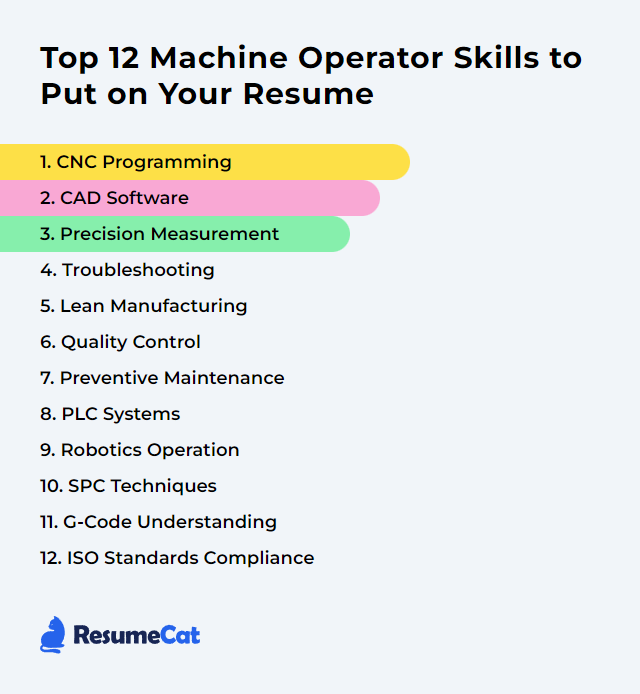Top 12 Machine Operator Skills to Put on Your Resume
Hiring managers skim fast. A machine operator who blends sharp technical chops with safety instincts and steady teamwork stands out. Put skills on the page that prove you can run complex equipment cleanly, spot trouble early, and keep throughput humming without cutting corners.
Machine Operator Skills
- CNC Programming
- CAD Software
- Precision Measurement
- Troubleshooting
- Lean Manufacturing
- Quality Control
- Preventive Maintenance
- PLC Systems
- Robotics Operation
- SPC Techniques
- G-Code Understanding
- ISO Standards Compliance
1. CNC Programming
CNC programming translates design intent into machine moves—cuts, drills, interpolations—so parts come off the machine on spec. You guide the code, set the stage, and let precision do the heavy lifting.
Why It's Important
It drives accuracy, repeatability, and cycle time. Good code means fewer crashes, better finishes, and smoother production.
How to Improve CNC Programming Skills
Master core codes: G/M codes, work offsets, tool length/diameter comp, canned cycles.
Use macros wisely: Variables, subprograms, and logic to reduce repetition and errors.
Optimize toolpaths: High-efficiency strategies, climb milling, constant chip load, minimal air-cuts.
Simulate and dry-run: Catch overtravel, collisions, and wrong offsets before metal meets metal.
Tune posts and defaults: Standard feeds, speeds, coolant, and safe retracts baked into your templates.
Document setups: Photos, fixtures, zero points, tool lists—so the next run starts fast.
How to Display CNC Programming Skills on Your Resume

2. CAD Software
CAD turns concepts into precise models and drawings. Clean geometry upstream saves headaches downstream.
Why It's Important
Machines only cut what you define. Tight models and drawings reduce scrap, chatter, and guesswork.
How to Improve CAD Software Skills
Think parametric: Use constraints, sketches, and design tables for quick edits.
Prep for CAM: Model with machining in mind—radiuses, stock allowances, fixturing faces.
Know your formats: Export clean STEP/IGES/DXF files and verify tolerances survive the trip.
Apply GD&T correctly: Datum schemes that reflect real inspection and assembly.
Organize revisions: Clear naming, change notes, and version control to stop mix-ups.
Run quick checks: Interference, draft, wall thickness, and basic simulation where useful.
How to Display CAD Software Skills on Your Resume

3. Precision Measurement
Measuring, not guessing. Using the right instruments and technique to confirm parts match print tolerances.
Why It's Important
Quality hinges on numbers that hold up. Tight measurement avoids rework and keeps customers happy.
How to Improve Precision Measurement Skills
Calibrate on schedule: Traceable intervals, stickers updated, out-of-tolerance tools pulled.
Match tool to task: Micrometers, bore gauges, height stands, indicators—use the right one.
Control the environment: Temperature, clean surfaces, deburred edges, stable setups.
Refine technique: Consistent contact pressure, cosine error awareness, probe seating.
Quantify variation: Gage R&R and uncertainty so decisions are based on capability.
Document results: Digital logs and simple charts to spot drift early.
How to Display Precision Measurement Skills on Your Resume
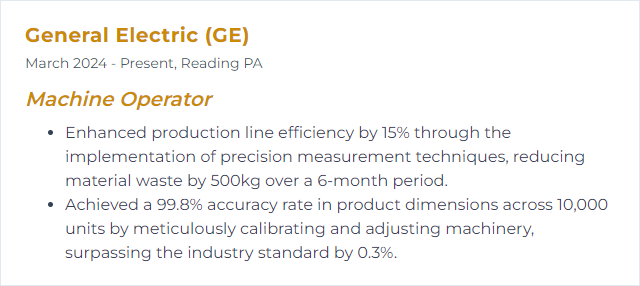
4. Troubleshooting
Finding root cause without flailing. Systematic checks, clean hypotheses, quick containment.
Why It's Important
Less downtime, fewer scrapped parts, safer floors. Problems shrink when you diagnose fast and fix once.
How to Improve Troubleshooting Skills
Standardize your approach: Verify basics first—power, air, coolant, tooling, offsets, alarms.
Baseline normal: Record current, vibration, temp, and cycle signatures when things are good.
Isolate smart: Swap one variable at a time; replicate issues on safe test runs.
Trace history: Review last-change events—material lot, program edit, tool, fixture, maintenance.
Document and escalate: Clear notes, photos, and data to pull in maintenance or engineering fast.
Stay safe: Lockout/tagout, guards in place, no shortcuts.
How to Display Troubleshooting Skills on Your Resume

5. Lean Manufacturing
Make more with less—less motion, less waiting, fewer defects. Flow that feels smooth to run.
Why It's Important
Lean trims waste, raises throughput, and builds safer, calmer work cells.
How to Improve Lean Manufacturing Skills
5S relentlessly: Sort, set in order, shine, standardize, sustain—daily habit, not a poster.
Cut changeover time: SMED practices, quick clamps, pre-staged tools, standardized setups.
Balance to takt: Match cycle times to demand; smooth the bottlenecks first.
Use visual controls: Shadow boards, kanban cards, status lights, simple dashboards.
Standard work: Clear steps, time targets, and quality checks baked in.
Kaizen small: Frequent micro-improvements beat rare big bangs.
How to Display Lean Manufacturing Skills on Your Resume
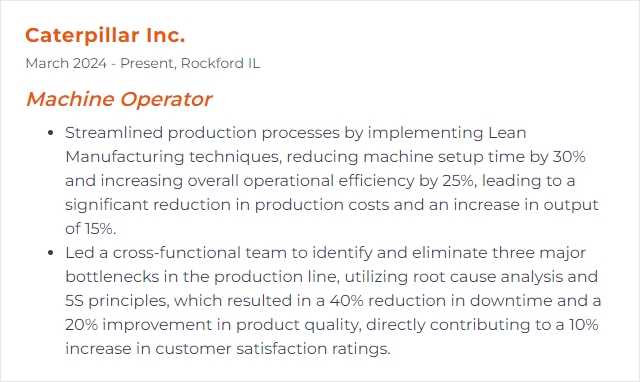
6. Quality Control
Building quality into the run, not checking it in at the end. Tight feedback loops while the chips fly.
Why It's Important
Prevents defects at the source and protects margins. Customers feel it, immediately.
How to Improve Quality Control Skills
Set checkpoints: First-article, in-process, and last-off inspections that actually trigger actions.
Use clear criteria: Visual aids, samples, and acceptance limits so no one is guessing.
Control the process: Simple SPC charts and react plans when points drift.
Handle nonconformances fast: Tag, quarantine, contain, and document root cause/corrective action.
Close the loop: Feed findings back into programs, fixtures, and training.
How to Display Quality Control Skills on Your Resume

7. Preventive Maintenance
Planned care beats surprise failure. Small, regular tasks that keep machines honest.
Why It's Important
Higher uptime, safer operation, longer equipment life, steadier quality.
How to Improve Preventive Maintenance Skills
Create a living PM schedule: Intervals by hours, cycles, or condition—adjust as data rolls in.
Operator care: Clean, inspect, lubricate—daily checklists with quick visual cues.
Use condition signals: Vibration, temperature, and noise trends to predict issues early.
Manage spares: Critical parts identified, labeled, and ready; no last-minute scrambles.
Record everything: Work orders, failures, and fixes—so patterns pop.
Verify torque and alignment: Belts, couplings, and fasteners tightened to spec.
How to Display Preventive Maintenance Skills on Your Resume
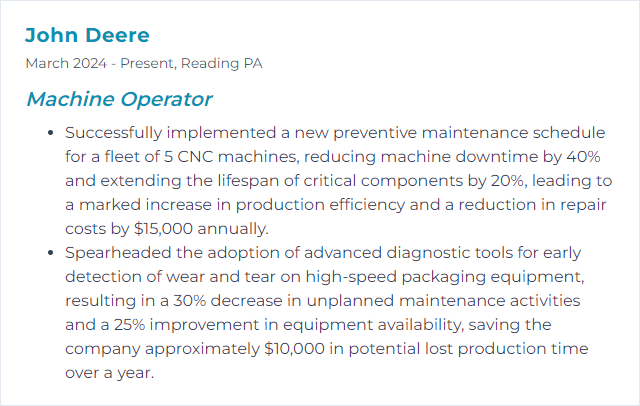
8. PLC Systems
PLCs execute the logic that runs cells and lines. Clear programs and clean wiring equal predictable machines.
Why It's Important
Stable automation means consistent quality and safer, faster production.
How to Improve PLC Systems Skills
Train on the platform you run: Ladder, function blocks, tags, and diagnostics.
Harden the network: Unique passwords, segmented cells, backups stored offline.
Control changes: Versioned code, approval steps, traceable edits, and fallbacks.
Design readable logic: Naming standards, comments, structured routines, and safe states.
Test HMIs: Clear alarms, simple navigation, and meaningful setpoints.
Preventive checks: I/O verification, sensor health, and e-stop tests on a schedule.
How to Display PLC Systems Skills on Your Resume
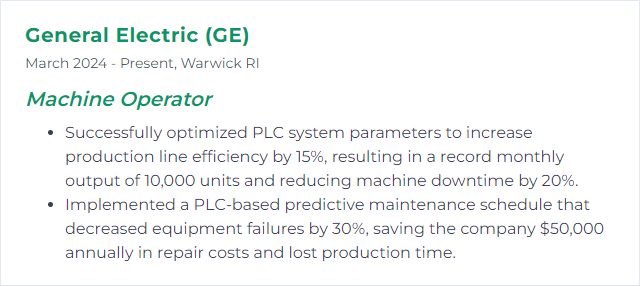
9. Robotics Operation
Teach, monitor, and refine robotic motion so the cell flows—safe, swift, repeatable.
Why It's Important
Robots boost precision and throughput while easing physical strain on people.
How to Improve Robotics Operation Skills
Dial in the teach: Accurate frames, approach paths, and recovery routines.
Respect safety: Risk assessments, safeguarded zones, tested interlocks, sensible speeds.
Optimize payload: Correct mass models, acceleration limits, and balanced EOATs.
Maintain EOAT and sensors: Gripper seals, vacuum lines, force/vision calibration.
Smooth the workflow: Minimize handoffs, reduce idle waits, buffer where it counts.
Keep software current: Backups, updates, and teach pendant housekeeping.
How to Display Robotics Operation Skills on Your Resume

10. SPC Techniques
Measure the process, not just the parts. Data that warns you before quality slips.
Why It's Important
SPC trims variation, reduces scrap, and keeps production inside the rails.
How to Improve SPC Techniques Skills
Pick the right charts: X-bar/R or I-MR, attributes when needed, clear control limits.
Define react plans: What to do at an out-of-control signal—no hesitation, just action.
Check measurement first: Gage R&R so your data can be trusted.
Sample smart: Small, frequent checks near the source beat big, late inspections.
Track capability: Cp/Cpk and Pp/Ppk to see if the process can actually hold spec.
Automate capture: Simple digital entry or direct feeds to cut manual errors.
How to Display SPC Techniques Skills on Your Resume
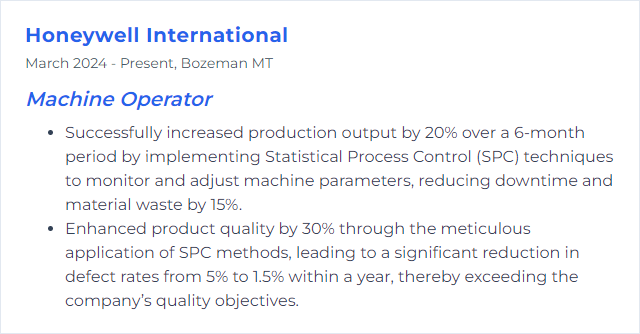
11. G-Code Understanding
The language machines obey. Motion control, tool changes, cycles—every move spelled out.
Why It's Important
Read, edit, and verify code to keep parts right and machines safe.
How to Improve G-Code Understanding Skills
Know the essentials: Motion (G0/G1), arcs (G2/G3), tool comp (G41/G42), and safe starts.
Use work coordinates: G54–G59, probing routines, and consistent zeroing.
Leverage canned cycles: Drilling, tapping, pecking, boring with correct retracts and pecks.
Mind feed and speed: Chip load, surface speed, and material-specific tweaks.
Protect the machine: Safe tool changes, clearance moves, and verified retract planes.
Practice with simulation: Visualize paths and validate code before running live.
How to Display G-Code Understanding Skills on Your Resume
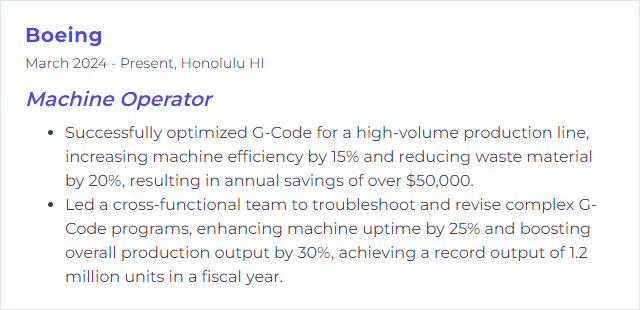
12. ISO Standards Compliance
Operating by documented standards so quality is repeatable and risk stays low. Procedures, records, and audits that actually improve the work.
Why It's Important
Consistent outputs, safer operation, and proof you meet customer and regulatory requirements.
How to Improve ISO Standards Compliance Skills
Follow current SOPs: Only the latest revision at the station; obsolete copies gone.
Record what matters: Lot traceability, inspections, calibrations, training—complete and legible.
Calibrate and verify: Instruments within date, with evidence of checks before use.
Control changes: Approved edits, training before rollout, and documented effectiveness checks.
Audit often: Layered process audits that catch drift and trigger corrective action.
Risk-based thinking: Identify failure modes, put controls in place, and monitor them.
How to Display ISO Standards Compliance Skills on Your Resume

